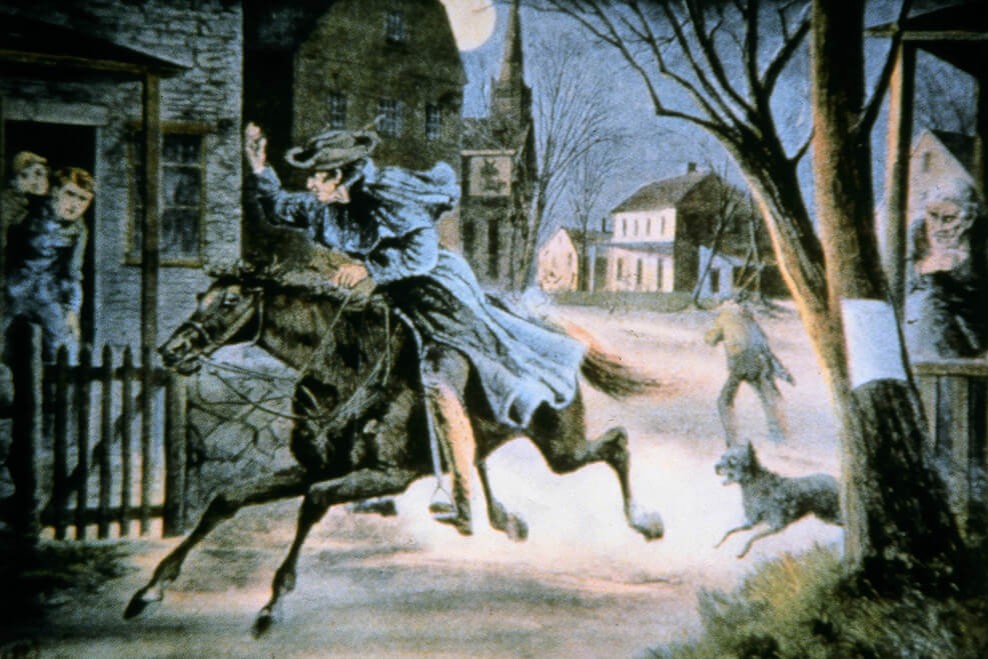Way back in the days of yore, we watched Schoolhouse Rock in kindergarten and elementary school. Infamous for its short episodes and songs about US history, math, and science, Schoolhouse Rock’s first episode aired back in 1973. I’m not sure if schools still play it now, but we had key lessons replayed so many times that I still remember most of them (*adds Schoolhouse Rock singing abilities to resume*). This one in particular was where we learned about Paul Revere and the message: “The British are coming!” that helped the US galvanize against the British and eventually gain our independence:
https://youtu.be/D727LW8GENQ
Admit it, you were singing along.
HOWEVER. It wasn’t just Paul Revere involved to spread that message on horseback — and previously, it wasn’t known that his horse even had a name. She did! Also…there were five voices of the Revolution!* The plot thickens…
The concept of having multiple riders gallop to different towns was an alarm system with “safety insurance.” If one rider was captured, important messages could still be spread — in this case, to Charlestown, Lexington, Concord, Philadelphia, and Danbury. The riders were:
- Paul Revere: Never actually shouted “The British are coming!” to move more quickly and safely. Eventually captured by the British outside of Lexington.
- William Dawes: Rode with Samuel Prescott, split up when they encountered the British, but then his horse threw him and bolted.
- Samuel Prescott: The only rider of the trio on April 18 (Revere, Dawes, Prescott) to reach Concord successfully.
- Israel Bissell: Rode his horse so hard that it died outside of Worchester. Rode the furthest of the five riders to Philadelphia.
- Sybil Ludington: 16 year-old woman who was able to recruit men to drive the British troops out of Danbury. Commended by George Washington for her heroism.
Prescott and Dawes made their rides on the night as Revere (April 18, 1777), where as Bissell made his in mid-April and Ludington rode on April 26, 1777.
 Photo via Paul Revere House.
Photo via Paul Revere House.
Now, on to Revere’s horse. Through the history books, it was traditionally depicted as a nondescript brown horse that Revere himself owned, but not much was actually known about it. Records have been uncovered that reveal that it actually was a mare, and she was indeed brown. For riders of the message alarm system, horses would have needed to be speedy and quick enough to cover ground, so she wouldn’t have looked like a large draft horse or one that pulled a cart laden with goods; she would have been built more lightly. The mare was owned by Samuel Larkin, and his son John Larkin lent her to Paul Revere. Originally, it was thought that her name was “Scheherazade,” but the following information surfaced in Larkin geneology records:
“Samuel [Larkin]… born Oct. 22, 1701; died Oct. 8, 1784, aged 83; he was a chairmaker, then a fisherman and had horses and a stable. He was the owner of ‘Brown Beauty,’ the mare of Paul Revere’s Ride made famous by the Longfellow poem. The mare was loaned at the request of Samuel’s son, deacon John Larkin, and was never returned to Larkin.”
Additionally, Brown Beauty may have been valued at approximately $60.00 based on the Larkin records — about $3,700.00 if she was alive today.
So, there we have it. Multiple riders, but Paul Revere certainly goes down in history as one of the most recognized voices out of the five — and he couldn’t have done the ride without Brown Beauty. Furthermore, without the alarm system that the voices of the Revolution utilized, we may have ended up in a much different place today had the war turned out differently.
Happy 4th of July!
*This was news to me…I thought there were two riders total.
References:
